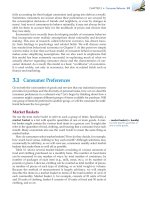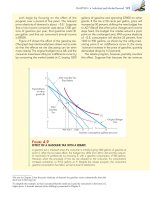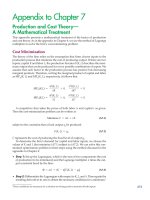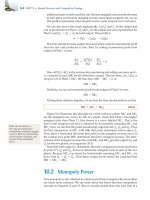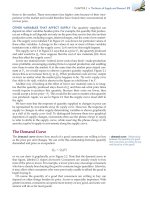(8th edition) (the pearson series in economics) robert pindyck, daniel rubinfeld microecon 114
Bạn đang xem bản rút gọn của tài liệu. Xem và tải ngay bản đầy đủ của tài liệu tại đây (100.11 KB, 1 trang )
CHAPTER 3 • Consumer Behavior 89
Explorer users, would prefer cars with $2500 worth
of acceleration and $7500 worth of size.7
We have simplified matters for this example by
considering only two attributes. In practice, an automobile company will use marketing and statistical
studies to learn how different groups of consumers value a broad set of attributes. Combined with
information about how these attributes will affect
manufacturing costs, the company can design a
production and marketing plan.
In the context of our example, one potentially
profitable option is to appeal to both groups of
consumers by manufacturing a model emphasizing acceleration to a slightly lesser degree than
preferred by those in Figure 3.14 (a). A second
option is to produce a relatively large number
of cars that emphasize size and a smaller number
emphasizing acceleration.
Knowledge about the preferences of each group
(i.e., the actual indifference curves), along with information about the number of consumers in each,
would help the firm make a sensible business decision. In fact, an exercise similar to the one we’ve
described here was carried out by General Motors
in a survey of a large number of automobile buyers.8
Some of the results were expected. For example,
households with children tended to prefer functionality over style and so tended to buy minivans rather
than sedans and sporty cars. Rural households, on
the other hand, tended to purchase pickups and allwheel drives. More interesting was the strong correlation between age and attribute preferences. Older
consumers tended to prefer larger and heavier cars
with more safety features and accessories (e.g., power
windows and steering). Further, younger consumers
preferred greater horsepower and more stylish cars.
Corner Solutions
Sometimes consumers buy in extremes, at least within categories of goods. Some
people, for example, spend no money on travel and entertainment. Indifference
curve analysis can be used to show conditions under which consumers choose
not to consume a particular good.
In Figure 3.15, a man faced with budget line AB for snacks chooses to purchase
only ice cream (IC) and no frozen yogurt (Y). This decision reflects what is called a
corner solution. When one of the goods is not consumed, the consumption bundle
appears at the corner of the graph. At B, which is the point of maximum satisfaction,
the MRS of ice cream for frozen yogurt is greater than the slope of the budget line.
This inequality suggests that if the consumer had more frozen yogurt to give up, he
would gladly trade it for additional ice cream. At this point, however, our consumer
is already consuming all ice cream and no frozen yogurt, and it is impossible to consume negative amounts of frozen yogurt.
When a corner solution arises, the consumer’s MRS does not necessarily equal the price
ratio. Unlike the condition expressed in equation (3.3), the necessary condition for
satisfaction to be maximized when choosing between ice cream and frozen yogurt
in a corner solution is given by the following inequality.9
MRS Ú PIC/PY
(3.4)
7
The first set of indifference curves for the Ford Mustang coupe will be of the following form: U (level
of utility) ϭ b0 (constant) ϩ b1 *S (space in cubic feet) * b2*S2 ϩ b3*H (horsepower) ϩ b4*H2 ϩ b5*O (a list
of other attributes). Each indifference curve represents the combinations of S and H that generate the
same level of utility. The comparable relationship for the Ford Explorer will have the same form, but
different b’s.
8
The survey design and the results are described in Steven Berry, James Levinsohn, and Ariel Pakes,
“Differentiated Products Demand Systems from a Combination of Micro and Macro Data: The New
Car Market,” Journal of Political Economy, 112 (February 2004): 68–105.
9
Strict equality could hold if the slope of the budget constraint happened to equal the slope of the
indifference curve—a condition that is unlikely.
• corner solution Situation
in which the marginal rate of
substitution of one good for
another in a chosen market
basket is not equal to the
slope of the budget line.

